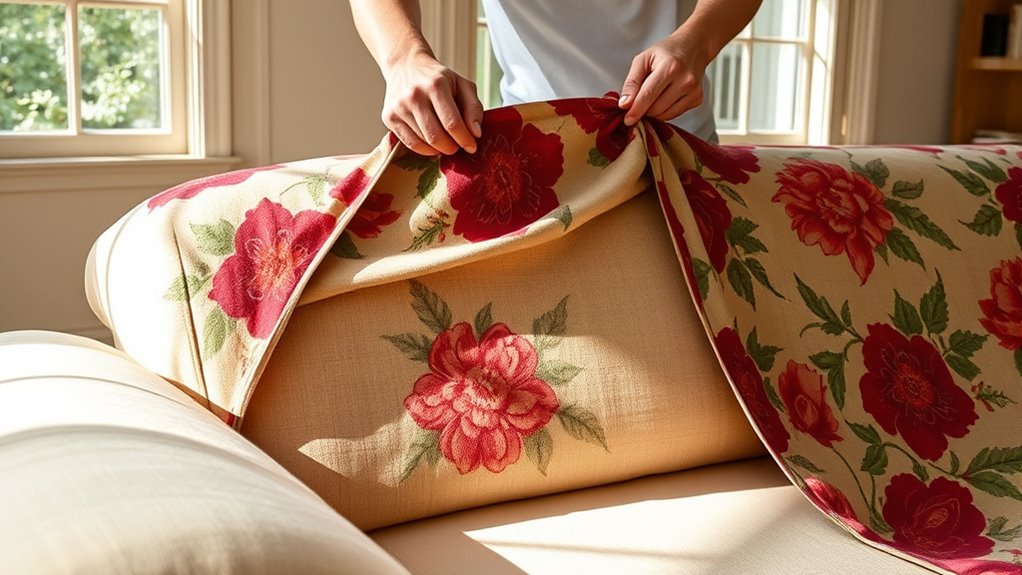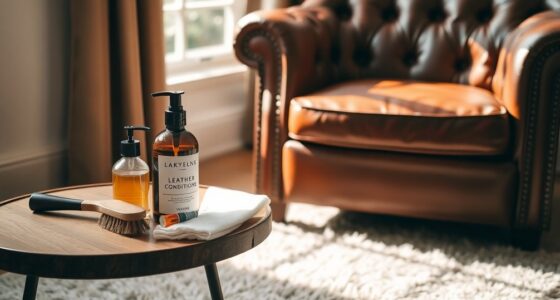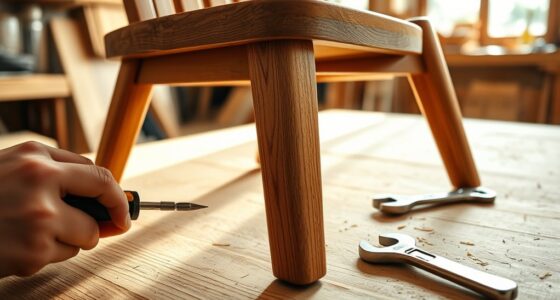To make and fit a sofa slipcover, start by choosing durable fabrics that match your décor and measuring your sofa precisely, including arms, back, and cushions. Cut your fabric carefully, allowing seam allowances, and sew pieces together with sturdy stitches, reinforcing stress points. Carefully pin or clip fabric as you assemble, ensuring a snug fit around corners and curves. For detailed step-by-step tips that ensure a perfect fit and lasting durability, keep exploring this helpful guide.
Key Takeaways
- Measure sofa dimensions accurately, including arms, back, and cushions, to ensure a snug fit.
- Choose durable, washable fabrics that complement your décor and suit your lifestyle needs.
- Cut fabric precisely with seam allowances, marking measurements carefully for proper fit.
- Sew slipcover pieces with reinforced seams and consistent stitch techniques for durability.
- Attach and secure the slipcover with elastic, drawstrings, or fasteners, and adjust for a smooth, tailored fit.

Creating a custom sofa slipcover is a practical way to refresh your furniture and protect it from everyday wear. When you decide to make one, the first step is selecting the right fabric. Your fabric choice impacts not only the look but also the durability and ease of care. Opt for sturdy materials like cotton duck, canvas, or polyester blends if you want something that withstands frequent use. If you prefer a softer feel, consider velvets or brushed fabrics, but remember they might require more maintenance. Think about the color and pattern as well—lighter shades can brighten up a room, while darker hues hide stains better. Make sure to choose a fabric that complements your décor and suits your lifestyle.
Once you’ve settled on the fabric, you need to think about your sewing techniques. Proper sewing techniques ensure that your slipcover fits snugly and holds together well over time. Start by carefully measuring your sofa, including the arms, back, and seat cushions, so you can cut your fabric pieces accurately. Use sharp scissors or a rotary cutter to get clean edges and mark your fabric with tailor’s chalk or fabric markers for precise sewing lines. When sewing, use a sturdy, straight stitch, and consider adding extra reinforcement at stress points like the corners and seams. If you’re new to sewing, take your time and do test stitches on scrap fabric first to get the tension and stitch length right. Seam allowances should be consistent—usually about half an inch—so your slipcover fits smoothly without bunching. Additionally, using proper seam finishes can help prevent fraying and extend the life of your slipcover. Incorporating easy sewing techniques can make the process more manageable. For example, finishing raw edges with a zigzag stitch or serger prevents fraying and prolongs the life of your slipcover. When attaching pieces, pin or clip them carefully to keep everything aligned, especially around corners and curves. You might also want to add decorative topstitching for a polished look or extra durability. If you’re sewing elastic or drawstrings into your slipcover, remember to leave enough extra fabric or casing to accommodate movement and tension. Throughout the process, stay organized by labeling your fabric pieces and keeping your workspace tidy, which helps prevent mistakes and saves time.
Frequently Asked Questions
What Tools Are Essential for Making a Slipcover?
You’ll need a sewing machine essentials kit, including needles, threads, and scissors, to craft your slipcover. Measuring tape techniques are vital for accurate dimensions; use it to measure sofa height, width, and depth precisely. Pins and fabric chalk help hold fabric in place and mark patterns. A seam ripper is handy for adjustments. With these tools, you’ll create a well-fitted slipcover that looks professional and fits perfectly.
How Do I Choose the Right Fabric for My Sofa?
You should choose fabric based on durability and how well it matches your decor. Investigate the theory that durable fabrics last longer and resist wear, making your slipcover more practical. Opt for a color that complements your existing furniture and room style, ensuring a cohesive look. Consider your lifestyle—if you have pets or kids, prioritize sturdy, stain-resistant materials. This way, your slipcover stays beautiful and functional over time.
Can I Make a Slipcover for an Irregularly Shaped Sofa?
Yes, you can make a slipcover for an irregularly shaped sofa. Focus on creating a custom fit by measuring each unique section carefully. Use flexible fabrics that adapt well to curves and angles. This allows you to incorporate a creative design that complements your sofa’s shape. With patience and precise sewing, you’ll craft a slipcover that looks tailored and stylish, perfectly accommodating your sofa’s distinctive form.
How Do I Prevent Wrinkles and Sagging Over Time?
To prevent wrinkles and sagging over time, focus on proper fabric care and sewing techniques. Use high-quality, wrinkle-resistant fabric and wash it as recommended to maintain its integrity. When sewing, guarantee tight, even stitches and add elastic or drawstrings at the edges for a snug fit. Regularly check and tighten these elements, and smooth the slipcover after each use to keep it looking fresh and fitted.
What Is the Average Time Needed to Complete a Slipcover?
Think of slipcover-making as a journey through a garden: it takes patience and care. Typically, DIY sewing with fabric selection takes around 4 to 8 hours, depending on your skill level and sofa size. If you’re meticulous, it might extend to a weekend. Planning ahead with precise measurements and choosing the right fabric can streamline the process, making your slipcover both quick to craft and beautifully fitting.
Conclusion
So, you’ve mastered the art of making and fitting a sofa slipcover—congratulations! Now, your sofa’s stylishly protected and you’ve saved a fortune, or so you think. Remember, a perfect slipcover isn’t just about aesthetics; it’s a reminder that sometimes, we hide our flaws behind pretty covers. Ultimately, whether your sofa stays pristine or gets a new stain tomorrow, it’s a reminder that nothing’s truly permanent—except maybe your obsession with perfect furniture.









